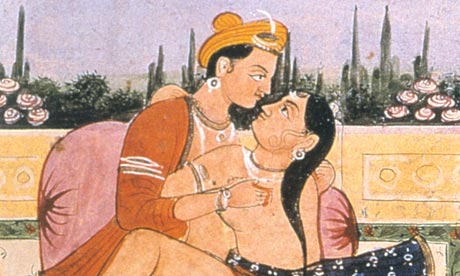
The Kama Sutra is being used to spread safe sex messages in India. Photograph: Sipa Press/Rex
It appears that sex is fun. This may not come as a surprise but, working in
sexual health,
one can easily become blind to that fact. To work in sexual and
reproductive health and rights is to be drip-fed a diet of warnings,
doom-laden data on violence, population and epidemics; no wonder we have
forgotten a central truth about sex – namely that it is pleasurable.
The
idea of pleasure and confidence in your sexual life is not a new
concept for us at IPPF (the International Planned Parenthood
Federation). In 1998, we enshrined the concept of respect and pleasure
in our youth manifesto, based on core values of respect for diversity,
informed choice and freedom of sexual expression and sexual enjoyment.
And then more recently in
Healthy, Happy and Hot – a young person's guide to rights, sexuality and living with HIV – where IPPF had the courage to suggest that
young people living with HIV could also live healthy and sexually fulfilling lives.
Now it seems the development community has caught up. The discussion around the new
sustainable development goals – replacing the
millennium development goals – are forcing us to re-examine the issue of sexual health and rights as the key to alleviating poverty and empowering women.
There
is growing evidence that promoting pleasure alongside safer sex
messaging can increase the consistent use of condoms and other forms of
safer sex. With this in mind, IPPF is beginning to reframe the debate on
sexual rights, health in terms of pleasure and confidence.
This
new, pleasure-positive approach couldn't have come at a more crucial
time. There is now general agreement that sustainable goals for
alleviating poverty and encouraging lasting development depend on
empowering women. Women's ability to contribute to their communities and
economies depends on empowerment, confidence and equality. Sexual
confidence, negotiation, collaboration and pleasure are all pivotal in
building gender equality and ending gender and sexual discrimination.
So
sex confidence is empowering. It's not just about not getting pregnant
or avoiding an STI (sexually transmitted infection), it's about being
comfortable with yourself, feeling accepted and accepting your partner,
treating the other person as a person and not a body. It's about being
confident and enjoying our bodies, having fun and not being forced into
having sex when we don't want to; about using education and information
to reinforce positive messages about safer sex, so that people of all
ages can enjoy it when they feel the time is right.
Western-led
discussions of sexual health have majored on facts, dire data and
warnings, and what not to do. We can help construct a sex-positive
language by talking about sex in our homes and families. It doesn't have
to be the "big talk" about sex; much better to start an open, ongoing
topic. Evidence shows that if you talk to teenagers about sex and
relationships, they'll feel less pressure to have sex, which means
they're more likely to wait.
The reproductive health community
needs to take some of the blame here, being curiously silent on the
subject of pleasure. Last year's
Family Planning Summit in
London made no reference or mention of it. If pleasure is the goal of
our sexual lives, discussion of pleasure is clearly key to encouraging
safer behaviours.
The generation of young people we want to reach
with safer sex messages are inundated by the language and drama of love
in films, song lyrics and soaps, yet most formal education literature
has all the eroticism of a car manual. Between the medicalised world of
sexual health and the commercialised world of the sex industry, we have
lost sight of the messy, emotionally-charged reality of sex.
We
need to find a more positive way of looking at sex that promotes sexual
pleasure, not as a side-issue but as a way to re-engage with our
audience – a chance to make our messages about sexual rights sexual and
safety more effective.
The Pleasure Project
has started the ball rolling by mapping initiatives around the world
that use pleasure as the primary motivation for promoting sexual health,
including working with Catholic churches in South Africa to improve sex
among married couples and using the
Kama Sutra to spread safe sex messages in India.
There's a long way to go. A report in the Lancet
noted obstacles to condom use including the extra effort needed, embarrassment and the perception of reduced pleasure.
The
Bill and Melinda Gates Foundation has issued a call to develop "the
next generation of condom that significantly preserves or enhances
pleasure, in order to improve uptake and regular use".
The
community and governments are waking up to the fact that recognising and
promoting pleasure and confidence in sex is vital to achieving
development goals. That's undoubtedly good news, but, meanwhile, let's
not forget that it's something to be sought and celebrated as an end in
its self.
Doortje Braeken is IPPF's senior adviser on
adolescents and young people, responsible for co-ordinating programmes
in 26 countries implementing a rights-based approach to youth friendly
services and comprehensive sexuality education.











